The Affordable Care Act
The Affordable Care Act. Ruth Colker Distinguished University Professor The Ohio State University Moritz College of Law. President’s signature. President Obama signed ACA into law with the strokes of 22 pens on March 23, 2010. Supreme Court Decision (June 28, 2012).
Share Presentation
Embed Code
Link
Download Presentation
- premium tax credits
- military insurance
- poverty level
- affordable care act
- new health insurance alternatives
- wellness programs

hall + Follow
Download Presentation
The Affordable Care Act
An Image/Link below is provided (as is) to download presentation Download Policy: Content on the Website is provided to you AS IS for your information and personal use and may not be sold / licensed / shared on other websites without getting consent from its author. Content is provided to you AS IS for your information and personal use only. Download presentation by click this link. While downloading, if for some reason you are not able to download a presentation, the publisher may have deleted the file from their server. During download, if you can't get a presentation, the file might be deleted by the publisher.
Presentation Transcript
- The Affordable Care Act Ruth Colker Distinguished University Professor The Ohio State University Moritz College of Law
- President’s signature • President Obama signed ACA into law with the strokes of 22 pens on March 23, 2010.
- Supreme Court Decision (June 28, 2012) • Upheld most of Affordable Care Act in a 5-4 decision • Anti-Injunction Act did not bar suit before Act went into effect • Not valid under Commerce Clause • But valid exercise of Congress’ taxing powers • Medicaid rules violated Spending Clause • Remedy: Give states option whether to opt in
- Many Uncertainties • Will states create exchanges or force federal government to create an exchange for their state? • Odd federalism dynamics! • Will states agree to expand Medicaid? • Will financial incentives on employers cause more of them to offer employer-based health insurance? • Will financial incentives for individuals cause more of them to purchase health insurance? • Will premiums rise or fall by virtue of new minimum requirements for health insurance?
- What does ACA already do?: • Insurers: • Cannot deny coverage of children under the age of 19 based on pre-existing conditions. • Cannot rescind coverage based on a review of the original application after someone gets sick. • Cannot impose lifetime dollar limits on essential benefits, like hospital stays. • Must cover certain services without charging a deductible, co-pay or coinsurance. • Preventive care and wellness visits, immunizations and some types of counseling and testing • Long list of preventive services for women including contraception
- More • Each state (or HHS) must create a pre-existing condition insurance plan for those who have been uninsured for at least six months because of a pre-existing condition. • Young adults are allowed to stay on their parents’ plan until they turn 26 years old (unless young adult is offered insurance at work). • Those who choose to stay on parents’ plan could potentially be those who need insurance, creating a selection risk issue • States are able to receive federal matching funds for covering some additional low-income individuals and families under Medicaid for whom federal funds were not previously available.
- Little Problem • Parents are getting used to covering their child up to age 26 on a family plan. Usually, there is no additional premium for extra children. • If child obtains job which OFFERS health insurance then parent’s policy will typically no longer cover child under age 26 rule. • But child will typically have to pay for insurance under new employer’s plan. • Child does need to purchase that insurance through new employer even though that is not the most economical decision.
- Rebates • 85 % of all premium dollars collected by insurance companies for larger employer plans must be spent on health care services or health care quality improvement. • 80 % of the premium must be spent on benefits and quality improvement for plans sold to individuals and small employers. • If costs are too high, then must provide rebates to consumers. • There has been some confusion about whether money must be returned to consumer or employer can use funds for wellness programs for all employees, because of language about “quality improvement.”
- Seniors • Provides a one-time, rebate check of $250 to seniors who reach the gap in Medicare prescription drug coverage known as the “donut hole.” • Seniors who reach the coverage gap will receive a 50 % discount when buying Medicare Part D covering brand-name prescription drugs. • Seniors receive free preventive services under Medicare. (That’s similar to rule for all insurance plans.)
- 2013 Rules • Employers must distribute a Summary of Benefits & Coverage to employees • Employers must report the value of health benefits on employees’ W-2 forms by January 2013 • $2,500 limit on employee contributions to health Flexible Spending Accounts • Requirement for employers to notify employees of the availability of health insurance exchanges
- What ACA Will do in 2014? • Prohibit discrimination due to pre-existing conditions or gender • Eliminates annual limits on insurance coverage • Tax credits for those whose income is between 133 % and 400 % of the poverty line who are not eligible for other affordable coverage. • Can buy health insurance through an Exchange. • Will have to pay a tax penalty if health insurance is available and affordable but has not been purchased by individual.
- Definition of Affordable • Not affordable if individual’s required contribution for the month exceeds 8 percent of such individual’s household income. For this purpose, the taxpayer’s household income shall be increased by any exclusion from gross income for any portion of the required contribution made through a salary reduction agreement. 26 USC § 5000A
- Definition of “required contributions” • Portion of employee’s annual premium if eligible to purchase minimum essential coverage through an employer-sponsored plan, or • For those without employer-offered health insurance, the annual premium for the lowest cost bronze plan available through an exchange reduced by the amount of available credit
- Definition of Household income • The modified adjusted gross income of the taxpayer, plus the aggregate modified adjusted gross incomes of all other individuals who were taken into account in determining the taxpayer’s family size and were required to file a return of tax for the taxable year. • Family size is equal to the number of individuals for whom the taxpayer is allowed a deduction for the taxable year.
- Odd Problem • Income is defined as HOUSEHOLD income, but • Premium (to see if affordable) is defined as premium for coverage through employer for an INDIVIDUAL • Required coverage to purchase, though, is for the FAMILY • So, employer could offer inexpensive individual coverage, which is deemed affordable in light of family income. Employee must then purchase family plan in order to avoid tax penalty.
- Premium Credits • Tax credits for insurance premium: • Contribute no more than 2 % AGI towards health insurance if less than 133 % of federal poverty line • Contribute between 2 and 9.5 % of AGI if 133 to 300 % of federal poverty line • Contribute no more than 9.5 % if 300 to 400 % of federal poverty line • No premium tax credits if over 400 % of federal poverty (but can take deduction if health costs above 10 % of AGI) or eligible for public coverage (Medicaid, CHIP, Medicare or military coverage)
- Subsidies • Cost sharing subsidies ranging from $604 (225 % of federal poverty line) to $4834 (125 % of federal poverty line) for things like deductibles, coinsurance • Cost sharing subsidy phases out at 225 % of federal poverty line whereas premium credit phases out at 400 %
- Medicaid • If states elect to participate: • Americans who earn less than 133% of the poverty level ($14,000 for an individual and $29,000 for a family of four) will be eligible to enroll in Medicaid. • States will receive 100% federal funding for the first three years, phasing to 90 % in subsequent years.
- Health Care Exchanges • Who are they available for? • Primarily serve individuals buying insurance on their own • Small businesses with up to 100 employees can also buy insurance through Small Business Health Options Program (SHOP) • What are rules governing insurance under exchanges? • Minimum basic coverage • Limits on out of pocket expenses
- Scope of Insurance Mandate • Employers with more than 50 employees (with exceptions we’ll discuss) • All individuals, unless: • Religious objection; undocumented immigrant; incarcerated; member of an Indian tribe • Family income is below threshold requiring you to file a tax return • You have to pay more than 8 % of your income for health insurance, after taking into account any employer contributions or tax credits • You were insured through Medicare, Medicaid, CHIP, military insurance, employer plan, or purchased insurance
- A Gap • In defining whether insurance is affordable to an INDIVIDUAL (so avoid penalties), threshold is 8 % of family AGI. • In defining whether an EMPLOYER has offered to affordable insurance (so it avoid penalties, as we will see), threshold is 9.5 % of family AGI.
- Individual Penalty for being without health insurance • 2014: $95 per adult and $47.50 per child (up to $285 for a family) or 1.0% of family income, whichever is greater • 2015: $325 per adult and $162.50 per child (up to $975 for a family) or 2.0 % of family income, whichever is greater • 2016 and beyond: $695 per adult and $347.50 per child (up to $2085 for a family) or 2.5 % of family income, whichever is greater • CBO estimates average annual premium for individual would be $4,500 – 5,000 and for a family would be $12,000 - $12,500 (equivalent to 2.5 % for 4-person family with income of $50,000).
- How ACA Affects Businesses • Small employers (fewer than 50 workers): • Imposes no new requirements • Provides new health insurance alternatives through state-based Small Business Health Options Program (SHOP) exchanges • If they offer insurance, may achieve some savings • State has option of combining small employer and individual exchange
- Small Business Tax Credit • Tax credits became available in 2010 to offset a portion of the purchase of health insurance by low-wage employers with 25 or fewer workers. • Tax credits up to 35 percent of the employer’s premium contribution available to an eligible employer until 2014 • Credits of up to 50 percent of the employer’s contribution will be available for two consecutive years as of January 1, 2014, for coverage purchased through the exchanges
- Coverage by Small Businesses • IF do provide coverage (voluntarily), they must limit waiting periods to no more than 90 days and eliminate lifetime and annual benefit limits. • IF offer dependent coverage then must make that coverage available for workers’ adult children up to age 26 (with no requirement that employer contribute to that coverage). • AND may not have pre-existing condition exclusions for children covered by health insurance
- New Plans sold in the small group market • Required to meet essential benefit requirements • Must be rated consistent with rating limits in the law • Must limit deductibles to $2,000 for single coverage and $4,000 for family coverage • Annual cost sharing limited to the current law for Health Savings Account limits ($5,959 for single coverage and $11,900 for family coverage in 2010)
- Grandfathered Plans • Need not meet essential eligibility requirements • BUT will have to meet those requirements if terminate current plan and purchase another one • HOWEVER, can allow family members of enrolled individuals to enroll without jeopardizing grandfathered status • AND can allow new employees of employer to join • Grandfathering will, in the short term, help firms that currently have an advantage in risk-rated insurance market • But if they purchase a new plan then new rules will likely increase expense of plan because part of larger risk pool
- Free Choice Vouchers • Rule available to employers in all size groups: • An amount equivalent to what the employer would have contributed to the firm’s plan on behalf of such a worker • Voucher allows worker to apply that amount toward the purchase of coverage through a nongroup insurance exchange • Worker using these vouchers are not eligible for premium subsidies in the exchange • No penalties will apply to employers providing them.
- When an employer with 50 plus employees must pay a penalty for not offering any coverage • At least one employee received a premium tax credit or cost sharing subsidy in an Exchange, then • Must pay penalty for not offering coverage: • Penalty is $2,000 annually times the number of full-time employees minus 30.
- When an employer with health insurance plan and 50 plus employees must pay a penalty for not offering affordable coverage • Two situations: • Insurance does not pay for at least 60 % of covered health care expenses for a typical population OR • Employees have to pay more than 9.5 % of FAMILY income for the employer coverage • AND some employees choose to buy coverage in an Exchange and receive a premium tax credit
- Calculation of Penalty • Penalty is $3,000 annually for each full-time employee receiving a tax credit, up to a maximum of $2,000 times the number of full-time employees minus 30.
- Odd Problems • Whether plan is affordable is determined by family income although employer may only be aware of the individual’s income. • Also, income is defined as AGI and an employer may not know an employee’s AGI (even if person is single).
- Medium-Size Employers (50 to 100) • Can purchase insurance through Exchanges • Can also benefit from “grandfather” rules so long as they retain their health insurance policies
- Large Employers (more than 100 workers) • Same penalties as for medium size firms if an employee chooses a subsidized, exchange option • Same penalties if do not provide insurance (but 98 % do) • Until 2017, can purchase insurance through exchanges • Beginning in 2017, that rule is up to the states
- Rules for Insurance Offered by Large Employers • These prohibitions do apply: • Preexisting conditions exclusions • Recissions • Lifetime and annual benefit limits • Therefore, large employers will likely need stop-loss insurance if they self-insure • These rules do NOT apply: • Rating rules • Essential benefits minimums • Limits on deductibles
- Self-Insured Plans • Considered “self-insured” if ANY portion of benefits result from self-insurance. • These obligations DO NOT apply: • Comprehensive coverage for health benefits package • Essential health benefits requirements • Prohibition of discrimination based on salary • Annual limitations on deductibles for employer-sponsored plan • Guaranteed issue and renewability of coverage
- Employers with more than 200 full-time workers • Employer must automatically enroll all full-time workers and all previously enrolled workers into a plan each year • Workers will have the opportunity to opt out if they choose • This rule applies to regular insurance as well as self-insurance plans
- Prescription Drug Change in Rules for Retirees • The Medicare Modernization Act of 2004 provides subsidy payments to corporations equal to 28 percent of their costs for retiree prescription drug benefits • Payments for retiree health benefits are tax deductible for the firm • But ACA no longer allows firms to deduct the 28 percent subsidy they were receiving from federal government as part of their health care expenses • Firms have taken a “write down” to reflect this change ($1.0 billion by AT&T alone) because the 28 percent deduction was previously taken as an “asset.”
- 2018 • Forty percent excise tax on “high-cost” plans • This tax will apply to the total cost of health coverage of an active or retired employee exceeding certain annual cost thresholds • Many employers will hit the excise tax threshold unless they take steps to cut costs or lower their cost increases • The tax of these “Cadillac plans” was delayed until 2018. So who knows what will really happen by 2018.
- Problems • People who earn between 100 and 133 percent of poverty guidelines will not be entitled to subsidies to buy insurance under assumption they would move to Medicaid. • If employer offers “affordable” individual plan, and have family, then must buy family plan (or be subject to penalties). • But family plan might be terrifically expensive. • Only assistance is deduction if expenses above 10 % of AGI
- How ACA affects Children’s Health Insurance Program • Children currently covered by CHIP between 100 % and 133 % of poverty would be transitioned to Medicaid • CHIP is funded through 2015, with increased federal match • CHIP eligible children (6 to 19 years old) who cannot enroll in the program due to federal allotment caps must be screened to determine if they are eligible for Medicaid and, if not, would be eligible for some new tax credits
- Longterm Care • Establishes the Community First Choice Option in Medicaid to allow states to provide community-based attendant supports and services to individuals with incomes up to 150 % FPL with disabilities who require an institutional level of care through a state plan amendment. • Provides states with new options for offering home and community-based services through a Medicaid State Plan Amendment rather than through a wavier for individuals with incomes up to 300 % of the maximum SSI payment • Creates the State Balancing Incentive Program to provide enhanced federal matching payments to eligible states to increase the proportion of non-institutionally-based long-term care services. • Extends the Medicaid Money Follows the Person Rebalancing Demonstration program through 2016
- Conclusion • Uncertainty: • Will states go through with threat not to participate in Medicaid expansion? • If so, will individuals in those states become eligible for premium credit and cost sharing subsidies? • Will all states set up Exchanges (eventually if not immediately)?
- Resources • Kaiser Family Foundation: • http://healthreform.kff.org/the-basics/employer-penalty-flowchart.aspx • Federal government website: • http://www.healthcare.gov/law/index.html • Pre-existing condition health care plan • For Ohio: https://www.ohiohighriskpool.com • Run by Medical Mutual of Ohio
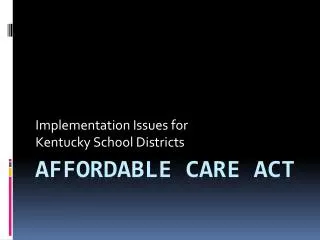
Affordable Care Act
Implementation Issues for Kentucky School Districts. Affordable Care Act. Presenters. Melissa Sullivan Melissa.Sullivan@education.ky.gov 502-564-3930 extension 4415 Susan Barkley Susan.Barkley@education.ky.gov 502-564-3930 extension 4437. Resources.
468 views • 39 slides
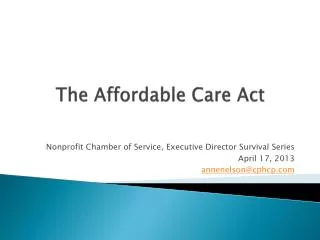
The Affordable Care Act
The Affordable Care Act. Nonprofit Chamber of Service, Executive Director Survival Series April 17, 2013 annenelson@cphcp.com. Health Reform Resource Project Sheldon Weisgrau, Director. Funded by Kansas Grantmakers in Health: Kansas Health Foundation Health Care Foundation of Greater KC
879 views • 70 slides

Affordable Care Act
Implementation Issues for Kentucky School Districts. Affordable Care Act. Presenters. Susan Barkley Susan.Barkley@education.ky.gov 502-564-3930 extension 4437 Jan Johnston Jan.Johnston@pendleton.kyschools.us 859-654-6911 Melissa Sullivan Melissa.Sullivan@education.ky.gov
501 views • 39 slides
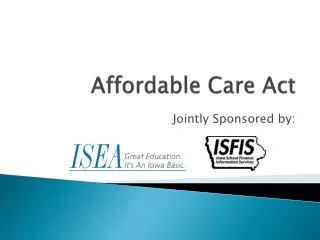
Affordable Care Act
Affordable Care Act. Jointly Sponsored by:. Webinar Reminders. PowerPoint at the following link: Use question pane to pose questions - all questions are private and there are no dumb questions!
393 views • 31 slides

The Affordable Care Act
Overview of the Law and Employer O bligations. The Affordable Care Act. Julia Martin Brustein & Manasevit, PLLC jmartin@bruman.com. Agenda. What is the Affordable Care Act? How does the law work? The Employer Mandate Deadlines and Things to Consider. What is the Affordable Care Act?.
568 views • 34 slides

Affordable Care Act
Affordable Care Act. Impact on Individuals, Small Employers and Non-Profits. Important Terms. Exchange – an organized marketplace for the purchase of state (or federal) regulated and standardized health care plans. Small business exchange is called “SHOP”
319 views • 22 slides

Affordable Care Act
Affordable Care Act. What does it mean for our families and communities?. Overview. Review of Affordable Care Act (ACA) Private insurance reforms and the Marketplace ACA and immigrants/refugees. Already Have Insurance?.
357 views • 20 slides

The Affordable Care Act
The Affordable Care Act. The Initial Effort to Overhaul the American Health Care System. Thomas Schlesinger, Ph.D. Executive Consultant. Access Quality. Cost. Given that the market, has been unable to address these problems, could the government used Medicare to reform healthcare?.
694 views • 52 slides
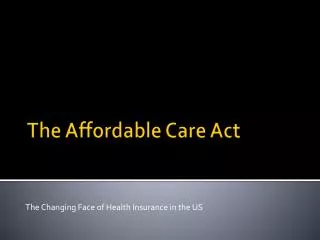
The Affordable Care Act
The Changing Face of Health Insurance in the US . The Affordable Care Act . PPACA Overview. The Patient Protection and Affordable Care Act is enacted March 23, 2010 (PPACA) Main Priorities Expansion of access to health care coverage Reduction of premium costs and make coverage affordable
521 views • 29 slides

Affordable Care Act
Affordable Care Act. SHRM April 10 th , 2013. Chris Keen Keen Insurance Associates- President 410-213-9060 / 410-251-8605 cell ckeen@keeninsurance.com . Affordable Care Act. Acronyms & Synonyms ACA Patient Protection and Affordability Care Act PPACA (“Pa Pac a”) Free Health Care
507 views • 31 slides

Affordable care act
Affordable care act . Consumer impact. What’s changing with the ACA?. What’s not changing with the ACA? Will have broad impact that affects some population groups more than others. Impact by insurance status. Impact greatest on uninsured/underinsured
259 views • 10 slides

Affordable Care Act
Affordable Care Act. U. S. Department of Health & Human Services Pamela Roshell, PhD, MSW Regional Director Region IV Atlanta, Georgia. U.S. Department of Health and Human Services . Mission:
557 views • 41 slides

The Affordable Care Act
The Affordable Care Act. David Riemer, Senior Fellow. Exchange Risk Pools: Policy Options for States. Michael Bare, Research and Program Coordinator. Project for Health Insurance Exchange Education (PHIXE). Exchanges. Health Insurance Exchanges Are a Centerpiece of ACA. By 11/16/2011….
206 views • 11 slides

The Affordable Care Act
The Affordable Care Act. The Impact of the Affordable Care Act on Prevention in Wisconsin September 2013. David Riemer, Senior Fellow Michael Bare, Research and Program Coordinator Community Advocates Public Policy Institute. Overview. What the ACA Changes:
499 views • 31 slides

The Affordable Care Act
The Affordable Care Act. The Impact of the Affordable Care Act on Prevention in Wisconsin October 2013. Mike Bare, Research and Program Coordinator Community Advocates Public Policy Institute. Health Insurance in Wisconsin Today. TRICARE Military. Providers Doctors Specialists
664 views • 47 slides
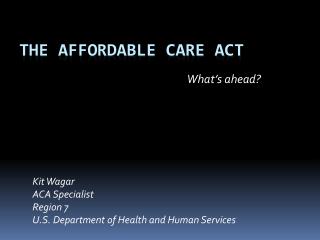
The Affordable care act
What’s ahead?. The Affordable care act. Kit Wagar ACA Specialist Region 7 U.S. Department of Health and Human Services. An Unsustainable System. The United States leads the world in discovering new approaches to prevent, diagnose, manage and cure illness
477 views • 34 slides

THE AFFORDABLE CARE ACT
THE AFFORDABLE CARE ACT. Presentation TO OBICI HEALTHCARE FOUNDATION BY Jill Hanken, Staff Attorney Virginia poverty law center May 2012. 700 E Main St. Suite 1410, Richmond, VA 23219. T : 804-782-9430 F: 804-649-0974. Virginia Poverty Law Center.
329 views • 25 slides

The Affordable Care Act
The Affordable Care Act. Outcomes. Participants will: Gain knowledge of the history of the Affordable Care Act; Understand the benefits for children Identify opportunities to support the provision and payment of Part C services. Health Reform Implementation.
367 views • 21 slides

The Affordable Care Act
The Affordable Care Act. Part II. October 17, 2014 Ross K. Airington, MPA VCU Office of Health Innovation. Background. Why Is Health Reform Needed?. In 2012, there were nearly 48 million uninsured Americans
796 views • 65 slides

The Affordable Care Act
The Affordable Care Act. A Presentation by the Delta Sigma Theta Sorority, Inc. National Social Action Commission. Dr. Paulette Walker , National President Rev. Dr. Gwendolyn Boyd , 22 nd National President, Co-Chair, National Social Action Commission
579 views • 46 slides

Affordable Care Act
Affordable Care Act. SHRM April 10 th , 2013. Chris Keen Keen Insurance Associates- President 410-213-9060 / 410-251-8605 cell ckeen@keeninsurance.com. Affordable Care Act. Acronyms & Synonyms ACA Patient Protection and Affordability Care Act PPACA (“Pa Pac a”) Free Health Care
523 views • 31 slides

The Affordable Care Act
The Affordable Care Act. Can Employers Afford It?. • Jason Altmire, Senior Vice President, Florida Blue
215 views • 10 slides
























